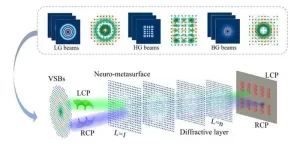(Press-News.org) WASHINGTON --- Clinicians at Georgetown University’s Lombardi Comprehensive Cancer Center reported promising preliminary findings based on outcomes in the first six patients with metastatic pancreatic cancer enrolled in a phase 2 clinical trial of the experimental drug BXCL701 in combination with the immunotherapy drug pembrolizumab (Keytruda). Immunotherapy drugs alone have not shown to be responsive to pancreatic cancer.
The findings were presented at the American Society of Clinical Oncology 2024 annual meeting in Chicago on June 1, 2024 (LBA4132).
BXCL701, made by BioXcel Therapeutics, is an oral drug called an immune activator. It acts by inflaming the microenvironment surrounding the tumor and thereby augmenting the activity of immunotherapies like pembrolizumab. BXCL701 has received Orphan Drug Designation from the U.S. Food and Drug Administration in pancreatic cancer and three other cancer types: acute myelogenous leukemia, stage IIb to IV melanoma, and soft tissue sarcoma.
Pancreatic cancer is the third leading cause of cancer death. The 5-year survival rate for all stages of the disease is 13% but there’s no early detection method and therefore patients are often diagnosed with later stage disease. For those with disease that has spread beyond the pancreas, the 5-year survival rates are an extremely low 3%.
“Pancreatic cancer is a devastating disease that is difficult to treat with standard methods, including chemotherapy,” says Benjamin Adam Weinberg, MD, an associate professor of medicine at Georgetown Lombardi and lead investigator of this trial. “Using immunotherapy alone to harness the body’s own immune system has also generally not worked due to the inability of immune cells to infiltrate pancreatic tumors due to dense fibrous tissue that walls tumors off microscopically from the immune system. Hence the need to find another approach.”
In pre-clinical mouse studies, published in 2021, researchers led by Louis Weiner, MD, director of Georgetown University’s Lombardi Comprehensive Cancer Center, showed that when combined with an immunotherapy drug, BXCL701 boosted the animals’ natural immune systems, slowing or even stopping pancreatic tumor growth. The mouse studies found evidence that tumors had been flooded by natural killer immune cells, a sign that the drug had accomplished its goal of making cancer cells receptive to the immune system. In short order, these mouse studies led directly to this first-in-human trial of the drug in pancreatic cancer.
For the initial part of the trial looking primarily at the safety aspect of the drug combination, three women and three men with a median age of 57 were enrolled. One patient showed no signs of disease progressing after 18 weeks on the trial and one patient had stable disease at 9 weeks but was not yet evaluable for the 18-week landmark. The progression-free survival rate (no change or even signs of regression in the tumor) as determined by imaging was 50%.
Three patients had significant reductions in a marker that indicates the presence of pancreatic cancer, CA19-9, with 100%, 97% and 73% reductions. Weinberg says that CA19-9 is the best marker they have in pancreatic cancer, but it is not as good a screening test as PSA is for prostate cancer. He believes, however, that it can be useful for monitoring disease activity in patients with advanced cancers. Not every patient’s tumor makes CA19-9 but so far in this study all patients have had elevated CA19-9 levels.
According to Weinberg, the main side effect so far is low blood pressure, which can be mitigated by giving BXCL701 at a lower dose during the first week of treatment. The clinicians are also seeing anemia, nausea, and immune-related arthritis, which has responded to oral steroids.
“Historically, no one has responded to immunotherapy in pancreatic cancer so even one response and another with stable disease could be early signs of efficacy,” says Weinberg. “A third patient had an initial drop in their CA19-9 marker even though they had disease progression on imaging, and this may be more early evidence that this drug combination has anti-cancer effects.”
###
In addition to Weinberg, authors include Alexander Lekan, Allison Fitzgerald, Zoe Malchiodi, Martin Gutierrez, Anteneh A. Tesfaye, Ming Tony Tan, Marcus Smith Noel, Aiwu Ruth He, Reetu Mukherji, John Marshall, Princess Jones, Pascal Borderies, Vincent O'Neill and Louis M. Weiner at Georgetown and the Georgetown-affiliated John Theurer Cancer Center, Hackensack University Medical Center, Hackensack, NJ.
Weinberg reports having no personal financial interests related to the study. Weiner’s research is supported in part by BioXcel Therapeutics, Inc., the company developing BXCL701. Support for his work is also provided by the Edwin and Linda Siegel Family Foundation. Weiner reports no other conflicts related to the study. The clinical trial is supported by BioXcel Therapeutics, Inc. and Merck.
About Georgetown University’s Lombardi Comprehensive Cancer Center
Georgetown’s Lombardi Comprehensive Cancer Center is designated by the National Cancer Institute (NCI) as a comprehensive cancer center. A part of Georgetown University Medical Center, Georgetown Lombardi is the only comprehensive cancer center in the Washington D.C. area. It serves as the research engine for MedStar Health, Georgetown University’s clinical partner. Georgetown Lombardi is also an NCI recognized consortium with John Theurer Cancer Center/Hackensack Meridian Health in Bergen County, New Jersey. The consortium reflects an integrated cancer research enterprise with scientists and physician-researchers from both locations. Georgetown Lombardi seeks to improve the diagnosis, treatment, and prevention of cancer through innovative basic, translational and clinical research, patient care, community education and outreach to service communities throughout the Washington region, while its consortium member John Theurer Cancer Center/Hackensack Meridian Health serves communities in northern New Jersey. Georgetown Lombardi is a member of the NCI Community Oncology Research Program (UG1CA239758). Georgetown Lombardi is supported in part by a National Cancer Institute Cancer Center Support Grant (P30CA051008). Connect with Georgetown Lombardi on Facebook (Facebook.com/GeorgetownLombardi) and Twitter (@LombardiCancer).
About Georgetown University Medical Center
Georgetown University Medical Center (GUMC) is an internationally recognized academic health and science center with a four-part mission of research, teaching, service and patient care (through MedStar Health). GUMC’s mission is carried out with a strong emphasis on public service and a dedication to the Catholic, Jesuit principle of cura personalis -- or “care of the whole person.” The Medical Center includes the School of Medicine and the School of Nursing & Health Studies, both nationally ranked; Georgetown Lombardi Comprehensive Cancer Center, designated as a comprehensive cancer center by the National Cancer Institute; and the Biomedical Graduate Research Organization, which accounts for the majority of externally funded research at GUMC including a Clinical and Translational Science Award from the National Institutes of Health. Connect with GUMC on Facebook (Facebook.com/GUMCUpdate) and Twitter (@gumedcenter).
#####
END
Experimental therapy shows promise in pancreatic cancer clinical trial
2024-06-01
ELSE PRESS RELEASES FROM THIS DATE:
Clinical trials show promise in treating central nervous system lymphoma, breast cancer, and glioblastoma
2024-06-01
Boston – Dana-Farber Cancer Institute researchers are leading 3 separate studies with encouraging results in treating patients with central nervous system (CNS) lymphoma, breast cancer, and glioblastoma. The studies support future research in these potential breakthroughs where treatment options may be limited. The research teams will present their findings at the 2024 Annual Meeting of the American Society of Clinical Oncology (ASCO) in Chicago, May 31-June 4, 2024. ASCO is the world’s largest clinical cancer research meeting, attracting more than 30,000 global oncology professionals.
These findings are among more than 80 studies presented at ASCO that ...
Crisis intervention program leverages social media to reduce suicide risk
2024-06-01
An Oregon-based program that monitors social media use may have helped deter more than 150 youth suicide attempts in the five years it’s operated, reports a new study published online today in the journal Psychiatric Services.
Staff with Lines for Life, a nonprofit that operates mental health crisis support services, and researchers at Oregon Health & Science University collaborated to closely document interventions by the Safe Social Spaces program, launched in 2019 by Lines for Life.
The study’s senior author said it’s an example of meeting people where they are.
“Community engagement is critical,” said Alan Teo, M.D., M.S., associate professor of ...
An unlikely hero in evolution: worms
2024-06-01
One of Earth’s most consequential bursts of biodiversity—a 30-million-year period of explosive evolutionary changes spawning innumerable new species—may have the most modest of creatures to thank for the vital stage in life’s history: worms.
The digging and burrowing of prehistoric worms and other invertebrates along ocean bottoms sparked a chain of events that released oxygen into the ocean and atmosphere and helped kick-start what is known as the Great Ordovician Biodiversification Event, roughly 480 million years ago, according ...
Detecting machine-written content in scientific articles
2024-06-01
The recent surge in popularity of AI tools such as ChatGPT is forcing the science community to reckon with its place in scientific literature. Prestigious journals such as Science and Nature have attempted to restrict or prohibit AI use in submissions, but are finding it difficult to enforce because of how challenging it is becoming to detect machine-generated language.
Because AI is getting more advanced at mimicking human language, researchers at the University of Chicago were interested in learning ...
Sorting complex light beams: A breakthrough in optical physics
2024-06-01
In the dynamic realm of optical physics, researchers are continually pushing the boundaries of how light can be manipulated and harnessed for practical applications. As reported in Advanced Photonics Nexus, a groundbreaking study from the Harbin Institute of Technology (HIT) introduces a method for sorting and distinguishing various types of vector structured beams (VSBs), promising significant advancements in optical communication and quantum computing.
Unlike conventional light beams that propagate in simple, straight trajectories, VSBs are engineered to form complex, intricate patterns. These beams transmit ...
Supervised physical exercise improves the wellbeing of carers of the elderly
2024-06-01
Mainly older and middle-aged women, working class, with a very high prevalence of lower back pain and consequently possible psycho-affective problems and a poorer quality of life... This is the general profile of carers of the elderly. Who cares for the carer? This question or demand is not new in our society. Members of the Ageing On research group of the University of the Basque Country (UPV/EHU) asked themselves the following question: “How can we care for the carers?”
The Ageing On group develops, ...
Polygenic risk scores give inaccurate and highly inconsistent results in embryo selection
2024-06-01
Polygenic risk scores (PRSs) are estimates of an individual’s susceptibility to a specific complex trait obtained by aggregating the effects of dozens, thousands, and potentially millions of genetic variants associated with that specific trait into a single figure. Some private companies now market PRS embryo screening to prospective parents through the use of in vitro fertilisation and pre-implantation genetic testing. While PRS has great potential for prediction in live-born (mostly adult) individuals, its accuracy ...
Molecular profiling improves diagnosis and survival for children with high risk cancers
2024-06-01
Berlin, Germany: Cancer is the leading cause of disease-related death in children in most developed countries, and at least a quarter of these patients are diagnosed with aggressive high-risk or relapsed cancers, with an expected five-year survival rate of less than 30%. Accurate diagnosis can be difficult, and survivors often suffer life-long side effects because of the toxic treatments needed to cure them. Now, researchers from Australia have shown that, by using precision medicine*, it is possible not only to obtain more accurate diagnoses, but also that using precision-guided, targeted treatments earlier improves the two year progression-free ...
New FRIB precision measurement program advances understanding of proton halos
2024-05-31
In May 2022, the Facility for Rare Isotope Beams (FRIB) at Michigan State University (MSU), launched its precision measurement program. Staff from FRIB’s Low Energy Beam and Ion Trap (LEBIT) facility take high-energy, rare-isotope beams generated at FRIB and cool them to a lower energy state. Afterward, the researchers measure specific particles’ masses at high precision.
The LEBIT team, led by Ryan Ringle, adjunct professor of physics at FRIB and in the MSU Department of Physics and Astronomy and senior ...
A greener, more effective way to kill termites
2024-05-31
UC Riverside scientists have discovered a highly effective, nontoxic, and less expensive way to lure hungry termites to their doom.
The method, detailed in the Journal of Economic Entomology, uses a pleasant-smelling chemical released by forest trees called pinene that reminds western drywood termites of their food. They follow the scent to a spot of insecticide injected into wood.
“We saw significant differences in the death rates using insecticide alone versus the insecticide plus pinene,” said UCR entomologist Dong-Hwan Choe, who led the discovery. “Without pinene, we got about 70% mortality. When we added it in, it was over 95%.
Native ...




